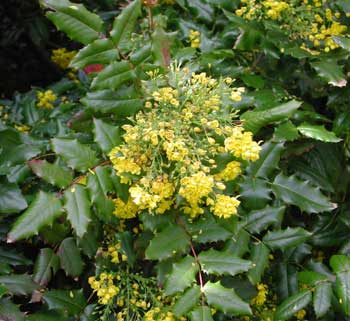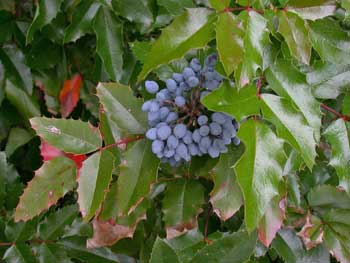Contents:
Common Names | Parts Usually Used | Plant(s) & Culture | Where Found | Medicinal Properties | Biochemical Information
Legends, Myths and Stories | Uses | Formulas or Dosages | How Sold | Warning | Bibliography
Scientific Names

- Berberis aquifolium
- Mahonia aquifolium L.
- Berberis repens L.
- Mahonia repens L.
- Berberidaceae
- Barberry family
Common Names
- California barberry
- Holly-leaved barberry
- Holly mahonia
- Mahonia
- Mountain grape
- Rocky Mountain grape
- Trailing mahonia
- Wild Oregon grape
Parts Usually Used
Root
Back to Top

Description of Plant(s) and Culture
Wild Oregon grape is an evergreen shrub; it has irregular, knotty roots that have brownish bark with yellow wood underneath. The branched stems extend to 3 feet or more and have alternate, pinnate leaves with 5 to 9 leaflets. Ovate or oblong lanceolate, the leathery, sessile leaflets have 10 or more spiny teeth on each side and are glossy dark green on top, pale green underneath. Yellow flowers bloom in fascicled racemes from April to May. The globular blue berries resemble bilberry (Vaccinium myrtillus L.), more commonly called huckleberries.
Oregon grape (B. repens), was used by Native Americans. Shoshone name “Sogo tiembuh’; Paiute name “Kaw-danup”; Blackfeet name “Oti to que.” The root was peeled, dried and steeped to check rectal hemorrhage, stomach troubles, and dysentery.
Back to Top
Where Found
Found in mountain areas on wooded slopes below 7000 feet from British Columbia to Idaho and southward to Oregon and California. Native to North America, introduced to Europe as a cultivated plant but has become naturalized there.
Back to Top
Medicinal Properties
Alterative, diuretic, laxative, tonic
Back to Top
Biochemical Information
Alkaloid berberine
Back to Top
Legends, Myths and Stories
There are several varieties of this herb, which appear to have similar properties. Thus, 4 are given here, because of this similarity.
This is the Pacific Northwest variety of barberry and was used by the mountain folk of California as a preferred treatment for all chronic degenerative diseases, especially cancer and arthritis. Used in the treatment of anemia, not because of the iron in the plant, but rather its ability to release iron stored in the liver.
Back to Top
Uses
Oregon Grape is used in the treatment of liver and kidney troubles, rheumatism, arthritis, hepatitis, jaundice, syphilis, anemia, constipation, leukorrhea, and uterine diseases. Good blood purifier and useful for scrofula and skin diseases such as eczema, acne, herpes, and psoriasis. Women drink it first thing in the morning to stimulate the onset of menstruation.
The medical used are almost identical to that of Barberry (Berberis vulgais).
Back to Top
Formulas or Dosages
Infusion: use 1 tsp. roots to 1 cup boiling water. Steep, strain. Take 1 tbsp. 3 to 6 times a day.
Tincture: a dose is from 5 to 10 drops in liquid daily.
Back to Top
How Sold
Dried herb and extract
Back to Top
Warning
Large doses have a cathartic effect, causing watery diarrhea and abdominal pains.
Avoid in pregnancy; a uterine stimulant.
Back to Top
Bibliography
![]() American Folk Medicine
American Folk Medicine, by Clarence Meyer, Meyerbooks, publisher, PO Box 427, Glenwood, Illinois 60425, 1973
![]() Back to Eden
Back to Eden, by Jethro Kloss; Back to Eden Publishing Co., Loma Linda, CA 92354, Original copyright 1939, revised edition 1994
![]() The Complete Medicinal Herbal
The Complete Medicinal Herbal, by Penelope Ody, Dorling Kindersley, Inc, 232 Madison Avenue, New York, NY 10016, First American Edition, copyright 1993
 Earl Mindell’s Herb Bible
Earl Mindell’s Herb Bible, by Earl Mindell, R.Ph., Ph.D., Simon & Schuster/Fireside, Rockefeller Center 1230 Avenue of the Americas, New York, New York 10020
![]() The Herb Book
The Herb Book, by John Lust, Bantam Books, 666 Fifth Avenue, New York, NY. copyright 1974.
![]() Indian Uses of Native Plants
Indian Uses of Native Plants, by Edith Van Allen Murphey, Meyerbooks, publisher, PO Box 427, Glenwood, Illinois 60425, copyright 1958, print 1990
![]() Planetary Herbology
Planetary Herbology, by Michael Tierra, C.A., N.D., O.M.D., Lotus Press, PO Box 325, Twin Lakes. WI 53181., Copyright 1988, published 1992
![]() Webster’s New World Dictionary
Webster’s New World Dictionary, Third College Edition, Victoria Neufeldt, Editor in Chief, New World Dictionaries: A Division of Simon & Schuster, Inc., 15 Columbus Circle, New York, NY 10023
![]() The Yoga of Herbs: An Ayurvedic Guide to Herbal Medicine
The Yoga of Herbs: An Ayurvedic Guide to Herbal Medicine, by Dr. David Frawley & Dr. Vasant Lad, Lotus Press, Twin Lakes, Wisconsin, Second edition, 1988.
 The Rodale Herb Book: How to Use, Grow, and Buy Nature’s Miracle Plants (An Organic gardening and farming book)
The Rodale Herb Book: How to Use, Grow, and Buy Nature’s Miracle Plants (An Organic gardening and farming book), edited by William H. Hylton, Rodale Press, Inc. Emmaus, PA, 18049., 1974
